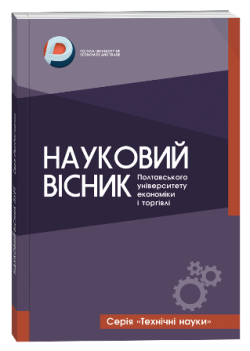Development of a technology for biscuit enriched with minerals
Abstract
One of the current problems in the nutrition of the population is the regular provision of the body with macro- and micronutrients. An important place among them belongs to calcium. The purpose of the research is the scientific justification and development of the recipe and technology of biscuit enriched with minerals due to egg shell powder. Subject of research - the amount of calcium in raw materials and finished products, physico-chemical and organoleptic properties of biscuit with different amounts of additives. Standard methods for determining humidity and porosity are used. The calcium content is determined by calculation. The role of calcium for the human body, methods of enriching flour confectionery products with minerals were studied. An analysis of the recipe and biscuit technology showed the possibility and stage of the introduction of the additive. Based on the results of the analysis of the chemical composition, it was found that the amount of calcium in 100 g of eggshell is 35 ... 40 g. The physiological norm of calcium requirement for an adult is 1000-1200 mg per day. To ensure the functionality of the additive, the minimum amount of calcium per 50 g of the finished product should be at least 300-360 mg. It was found that the weight of the supplement, which contains a functional amount of calcium, is 860 ... 900 mg. The amount of solids in the eggshell is 98.3 %. The additive was introduced by reducing the mass of flour. The functional amount of the additive is 3 % by weight. The amount of calcium may decrease during operation. The study was also conducted for samples with the replacement of flour by 5 % and 7 % of egg powder. For organoleptic evaluation, an optimal sample was created with the addition of 5 % by weight of flour. With an increase in the proportion of powder, the porosity of the products improves. The yield of the product with the additive increases. This gives the economic effect of introducing a new product. Thus, the optimal is the recipe for making biscuit with eggshell in the amount of 5 ... 5.5 % by weight of flour. Physico-chemical characteristics of the product (porosity, humidity) comply with the requirements of regulatory documentation. It was established that the consumption of 50 g of the product provides the human body with calcium on average by 23 ... 30 % of the daily requirement. The semi-finished product can be used as an independent product for the production of cakes and pastries to expand the assortment of flour confectionery products and to obtain products of high biological value. Egg shell powder can be used in the technology of other flour confectionery products.
References
2. Спиричев В. Б. Обогащение пищевых продуктов микронутриентами: научные принципы и практические решения / В. Б. Спиричев, Л. Н. Шатнюк // Пищевая промышленность. – 2010. – № 4. – С. 20–24.
3. Матвеева Т. В. Мучные кондитерские изделия функционального назначения. Научные основы, технология, рецептуры / Т. В. Матвеева, С. Я. Корячкина. – Санкт-Петербург : ГИОРД, 2016. – 360 с.
4. Шатнюк Л. Н. Мучные кондитерские изделия, обогащенные витаминами и минеральными веществами / Л. Н. Шатнюк, Т. В. Савенкова // Пищевые ингредиенты в производстве хлебобулочных и мучных кондитерских изделий. – Москва : ДеЛи плюс, 2013. – С. 190–220.
5. Разработка и обоснование технологи хлебобулочных изделий функционального назначения / И. В. Мацейчик, А. Н. Сапожников, А. Н. Ткач та ін. // Технологии пищевой и перерабатывающей промышленности АПК – продукты здорового питания. – 2016. – № 4. – С. 43–51.
6. Кочерга В. І. Теоретичні аспекти виробництва кондитерської продукції, збагаченої лактатом кальцію [Електронний ресурс] / В. І. Кочерга, Г. В. Скиданчук. – Режим доступу: http://dspace.nuft.edu.ua/jspui/bitstream/123456789/3952/1/calcium_lactate.pdf (дата звернення: 14.11.2019). – Назва з екрана.
7. Холобцева І. П. Обґрунтування технології отримання пісочного напівфабрикату, збагаченого засвоюваними сполуками кальцію / І. П. Холобцева, М. Л. Серік, О. В. Самохвалова // Розвиток харчових виробництв, ресторанного та готельного господарств і торгівлі: проблеми, перспективи, ефективність : матеріали міжнар. наук.-практ. конф. (м. Харків, 15 травня 2019 р.). – Харків : ХДУХТ. – С. 124–128.
8. Степанова Т. М. Перспективи застосування порошку яєчної шкарлупи в харчовому виробництві / Т. М. Степанова, Х. Усанов // Сучасні технології харчових виробництв : матеріали ІI міжнар. наук. конф. (м. Дніпро, 17–18 травня 2018 р.). – Дніпро : ДНУ імені Олеся Гончара. – С. 73–74.
9. Саломатов А. С. Исследование пенообразующей способности порошка яичной скорлупы / А. С. Саломатов, А. С. Саломатова // Вестник ЮУрГУ. Пищевые и биотехнологии. – 2013. – № 2. – С. 30–33.
10. Таблицы химического состава и калорийности российских продуктов питания : справочник / под ред. И. М. Скурихина, В. А. Тутельян. – Москва : ДеЛи принт, 2007. – 275 с.
11. Малахова В. В. Яичная скорлупа – минеральный обогатитель / В. В. Малахова // Птицеводство. – 2002. – № 11. – С. 24–26.
12. Сборник рецептур мучных кондитерских и булочных изделий для предприятий общественного питания. – Москва : Экономика, 1986. – 300 с.


